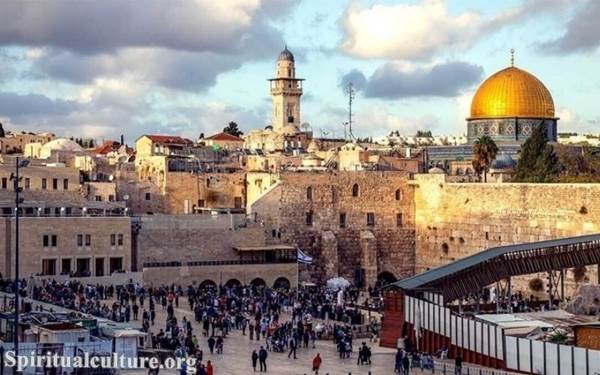The rich tapestry of Saudi Arabian cuisine is a profound reflection of its history, geography, and deep-seated values of hospitality and communal sharing. Stretching from the Red Sea coast to the vast Najd plateau, the local food embodies the resourceful Bedouin traditions, the wealth of the spice trade routes, and the sacred importance of dates and grains. Culinary traditions here are often inseparable from religious and family occasions, acting as a spiritual bridge connecting generations and affirming community bonds.
Food in the Kingdom is not merely sustenance; it is a profound cultural expression. The preparation of a large platter of rice and meat, such as Kabsa or Mandi, for communal dining is the ultimate act of generosity, a core tenet of Islamic hospitality. This list delves beyond simple popularity, ranking the dishes by their indelible cultural footprint, spiritual significance, and historical prevalence across the diverse regions of Saudi Arabia, validated by current cultural data.
The dishes listed below represent the most culturally dominant and spiritually significant foods, celebrating the heart and soul of Saudi heritage.
Table of the Top 10 Most Popular Saudi Foods by Cultural and Spiritual Significance
| Rank | Dish Name | Primary Region/Origin | Cultural/Spiritual Significance | Key Preparation Style |
|---|---|---|---|---|
| 1 | Kabsa (Kabsah) | Najd/Across KSA | The National Dish; Ultimate symbol of hospitality and communal unity. | Mixed rice, meat (lamb/chicken), and aromatic spices (cardamom, saffron) cooked together in one pot. |
| 2 | Mandi | Originated in Yemen; Highly popular in KSA | Celebration and Feast Food; Traditional Bedouin slow-roasting technique (underground oven). | Meat (lamb/chicken) marinated and slow-cooked, often in a Tannour or Tabun (earth oven), served over fragrant rice. |
| 3 | Jareesh | Najd | The Heritage Grain Dish; A staple for farmers and Bedouins; Symbolizes sustenance and simplicity. | Cracked/crushed wheat slow-cooked with laban (yogurt) or broth until creamy, topped with meat or onions. |
| 4 | Saleeg | Hejaz (Makkah & Taif) | The Comfort Dish of the Holy Cities; Frequently served during Eid and religious occasions. | White rice cooked with milk and/or broth until creamy, porridge-like consistency, served with roasted meat. |
| 5 | Dates & Qahwa (Arabic Coffee) | All Regions | The Spiritual Staple; Traditional welcome for guests; Central to breaking fast during Ramadan (Iftar). | Fresh/dried dates often consumed with Qahwa (cardamom-flavored light-roast coffee). |
| 6 | Ma’amoul | All Regions | The Celebration Cookie; Essential sweet for marking Eid al-Fitr and Hajj pilgrimage returns. | Shortbread pastry filled with dates or nuts, often pressed with intricate wooden molds. |
| 7 | Haneeth | Aseer (South) | The Mountain Feast Dish; Known for its unique smoky flavor from being slow-cooked with Markh leaves. | Lamb or goat slow-roasted in a deep pit (furn) or oven, traditionally infused with the aroma of Markh or Sala leaves. |
| 8 | Mutabbaq | Hejaz/Street Food | The Traveler’s Meal; A popular snack near pilgrimage sites (Makkah/Jeddah). | Savory stuffed flatbread/pancake folded into a square, typically filled with minced meat, egg, and herbs. |
| 9 | Ful Medames | Hejaz/Across KSA | The Breakfast Cornerstone; Simple, nutritious staple for daily life and pre-fasting (Suhur) in Ramadan. | Slow-cooked fava beans seasoned with cumin, lemon juice, and olive oil, served with Tamees bread. |
| 10 | Luqaimat | All Regions | The Sweetness of Gratitude; Popular during Ramadan for breaking the fast. | Small, yeast-leavened dough balls deep-fried until golden and crunchy, then soaked in date syrup or honey. |
Top 10. Luqaimat
Luqaimat, meaning “small bites” in Arabic, secures its place in the Saudi cultural heart as the quintessential sweet enjoyed during the holy month of Ramadan. These small, golden, crispy dumplings, traditionally leavened and drizzled with date syrup (dibs), are a testament to the region’s resourceful use of simple ingredients like flour, yeast, and honey/dates. As a staple dessert across the Gulf, its enduring popularity is tied directly to the communal spirit of Iftar, the evening meal when the fast is broken.
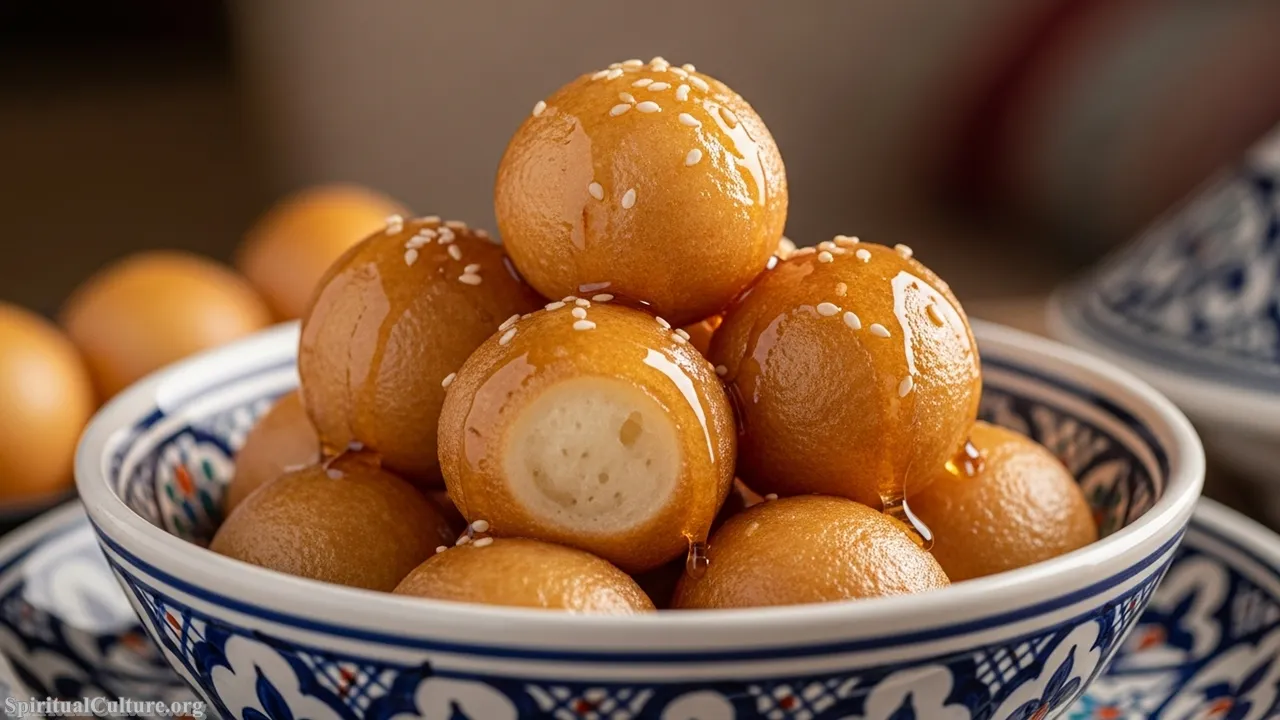
The reason for its high cultural ranking, despite its simplicity, lies in its role in the spiritual calendar. Sharing Luqaimat is an act of simple generosity and a cherished tradition that brings families together after a day of fasting. The sweetness is seen as a welcome blessing after abstinence, symbolizing the joy and gratitude felt upon completing the day’s devotion. It embodies the humanistic spirit of providing immediate, warm comfort to those who have exercised self-discipline.
The process of making Luqaimat—carefully forming the small dough balls and frying them to perfection—is often a multi-generational activity, preserving ancient techniques. It reflects the preservation of a communal kitchen heritage where food preparation is an act of love and duty. For Spiritual Culture, this sweet delicacy represents the small, consistent acts of worship and sharing that define the social fabric of the Kingdom.
Cultural/Spiritual Highlights
- Mandatory treat for Iftar (breaking the fast) during Ramadan.
- Symbolizes the sweetness and gratitude following a period of abstinence.
- Historically prepared and shared in large batches for neighbors and family.
Top 9. Ful Medames
Ful Medames, a hearty stew of slow-cooked fava beans, is a cornerstone of Saudi Arabian breakfast, particularly vital in the western Hejaz region but consumed widely. This dish highlights the significance of legumes in the Arabian diet, providing essential nourishment in a simple, affordable form. Often served with a drizzle of olive oil, cumin, and lemon, and scooped up with Tamees flatbread, it is the definition of a sustaining, unpretentious staple, beloved by all segments of society as of the Current Time of Writing.
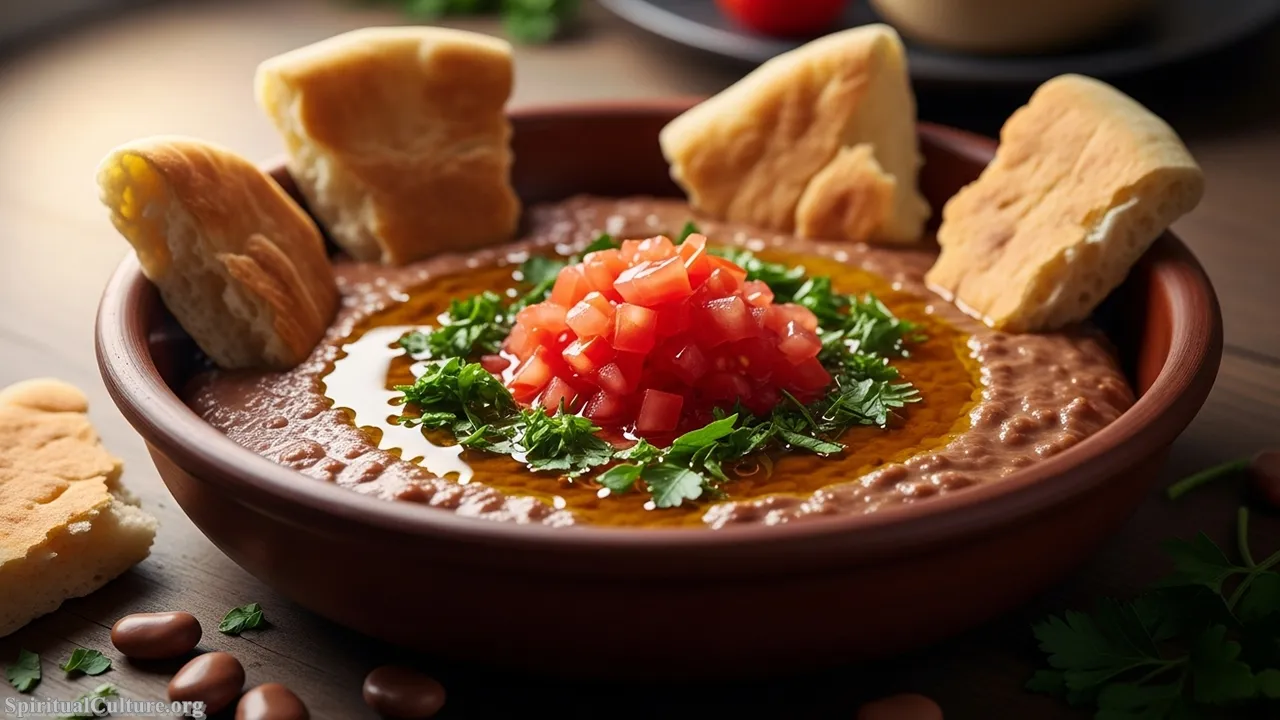
Its spiritual and cultural significance rests on its accessibility and role in preparing for religious duties. As an energy-packed meal, Ful is historically important for Suhur (the pre-dawn meal) during Ramadan, providing long-lasting energy for the fast ahead. This practical utility elevates it beyond a simple meal to a functional element of religious observance, affirming the cultural wisdom of utilizing basic ingredients for robust, communal sustenance.
The tradition of gathering around a simple, massive bowl of Ful underscores a democratic culinary culture where everyone, regardless of status, partakes in the same fundamental nourishment. It teaches a moral lesson in humility and thankfulness for the most basic of blessings. Spiritual Culture celebrates Ful Medames as the ultimate food of the people, a daily ritual that strengthens physical and spiritual readiness.
Cultural/Spiritual Highlights
- Staple Suhur (pre-dawn) meal during Ramadan for sustained energy.
- A historic dish with roots in ancient Egypt, demonstrating regional culinary exchange.
- Symbolizes the virtue of simplicity and accessible, nourishing food for all.
Top 8. Mutabbaq
Mutabbaq, translating literally as ‘folded,’ is a popular street food that reflects the historical trade and migratory interactions that shaped Saudi cuisine, particularly in the coastal Hejaz region. This savory, crispy, stuffed flatbread is pan-fried and typically filled with minced meat, eggs, and spring onions. While its origins may be traced to Yemen, its adoption and popularity in the Kingdom, especially around the holy cities of Makkah and Jeddah, firmly embeds it in the local culinary identity.
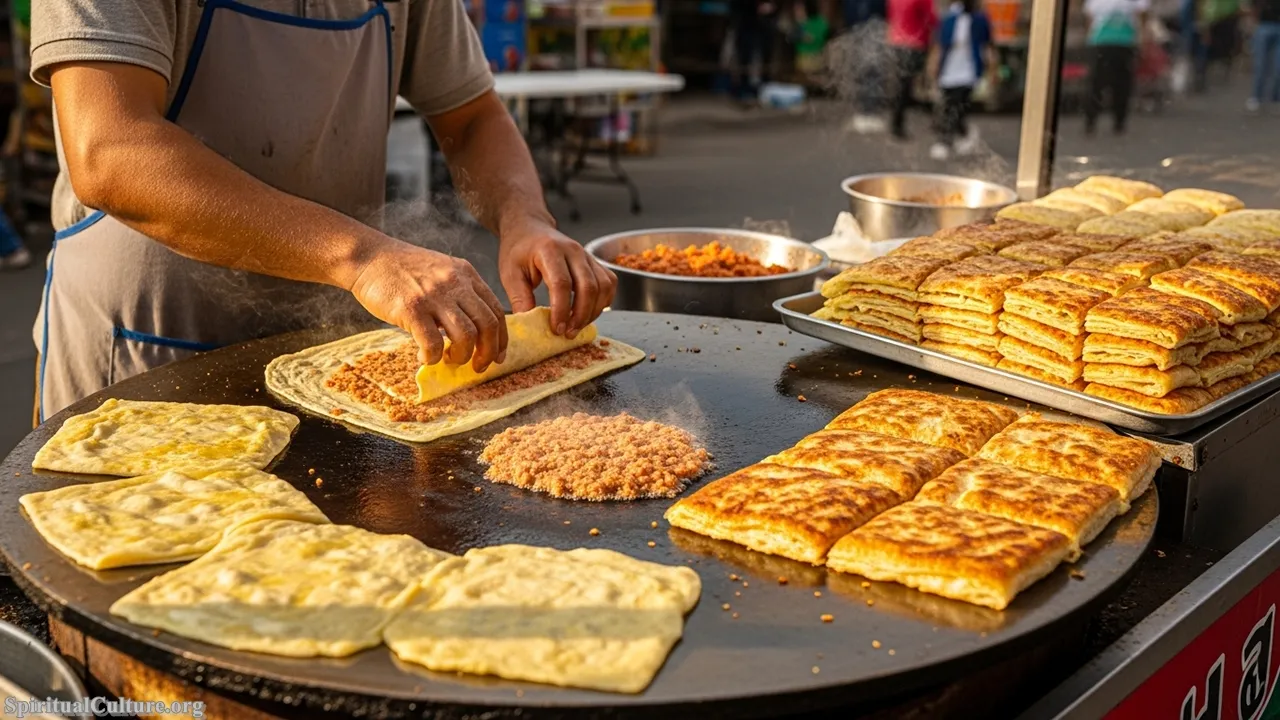
Its cultural importance is tied to the movement of people—pilgrims and traders—who required fast, hot, and satisfying sustenance. Mutabbaq’s easy portability and delicious heartiness made it a natural choice near the Grand Mosque during Hajj and Umrah seasons. The dish, therefore, holds a spiritual connection for many Muslims worldwide, representing a quick, communal snack shared during their most sacred journeys. It is a humble testimony to the resilience of a traveler’s diet.
The dish’s continued presence and local variation highlight the adaptability and cosmopolitan nature of Saudi culture. It represents the value of immediate hospitality—a dish that can be prepared and shared quickly on the street. For Spiritual Culture, Mutabbaq is a symbol of the culinary convergence that occurs in a region that hosts the world, a comfort food for millions of global pilgrims.
Cultural/Spiritual Highlights
- A widespread street food favorite, especially around the major pilgrimage sites.
- The name Mutabbaq (folded) reflects its distinctive, efficient preparation method.
- Represents the historical culinary influence from Yemen and India via trade routes.
Top 7. Haneeth
Haneeth is a majestic centerpiece dish from the Aseer region in southern Saudi Arabia, renowned for its deeply flavorful lamb or goat. Its preparation is what distinguishes it: the meat is seasoned, often wrapped in Markh or Sala leaves for flavor, and slow-cooked in a deep pit or furn (oven) until it reaches an incredible tenderness. This method is a preserved reflection of ancient, pre-modern Bedouin cooking techniques, making it a crucial element of culinary heritage.
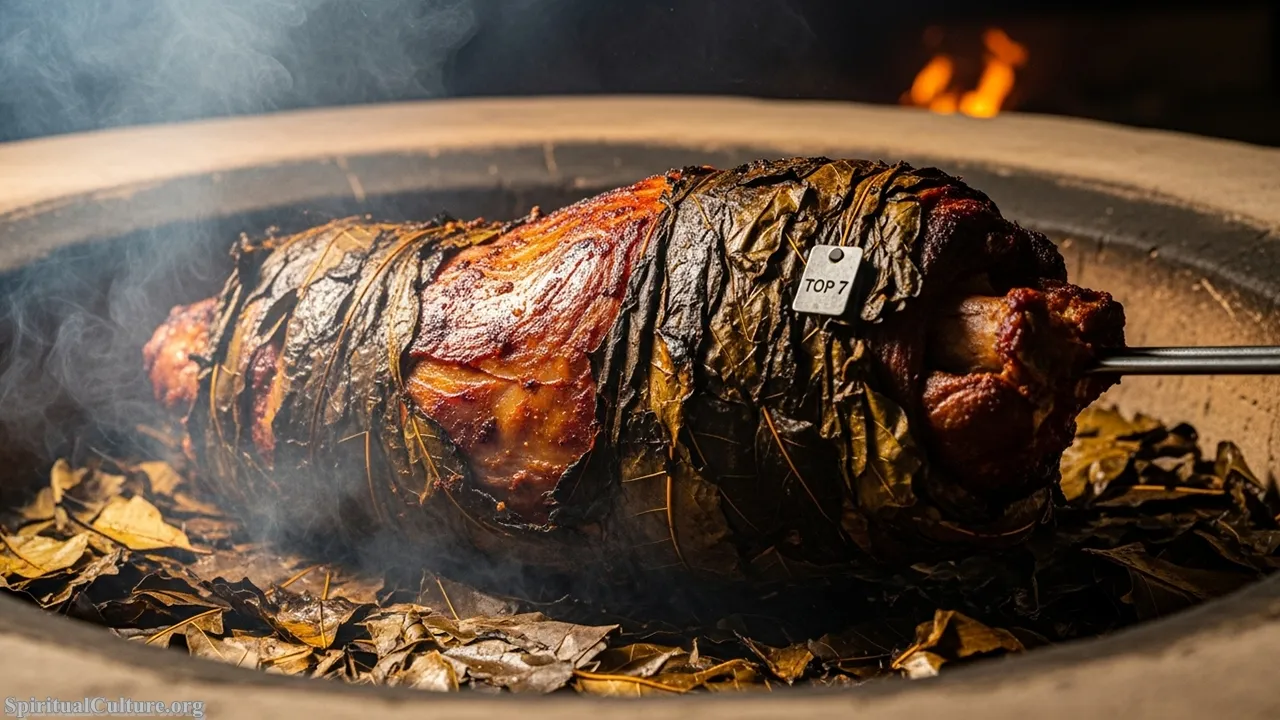
The high spiritual impact of Haneeth comes from its dedication to the tradition of sacrifice and celebration. It is a dish reserved for the most significant feasts, tribal gatherings, and especially for Eid al-Adha, following the sacrifice. Serving Haneeth is a supreme gesture of respect and honor toward guests and a celebration of abundance after a solemn religious ritual. Its smoky aroma and succulent texture are a sensory reminder of deep-rooted regional practices.
The value of preservation is visible in the continuity of the furn or underground oven technique, a practice that connects the current generation to the ancient wisdom of desert cooking. It requires skill, patience, and a deep respect for the meat. Spiritual Culture honors Haneeth as a monumental dish that perfectly encapsulates the solemnity and subsequent joy of Islamic celebrations, reinforcing the spiritual lesson of sharing and gratitude.
Cultural/Spiritual Highlights
- Reserved for major celebrations, feasts, and Eid al-Adha.
- Cooked using ancient, preserved Bedouin slow-roasting techniques in a pit or furn.
- The use of Markh leaves for infusion links the dish directly to the local flora and regional heritage.
Top 6. Ma’amoul
Ma’amoul is not merely a cookie; it is a profound cultural ritual and a true symbol of festivity across the Arabian Peninsula, especially in Saudi Arabia during the celebration of Eid. These buttery semolina or flour shortbread cookies are traditionally stuffed with date paste, pistachios, or walnuts and intricately shaped using special wooden molds. The preparation is a collective, generational effort, often involving women in the family gathering before the start of a major holy day.
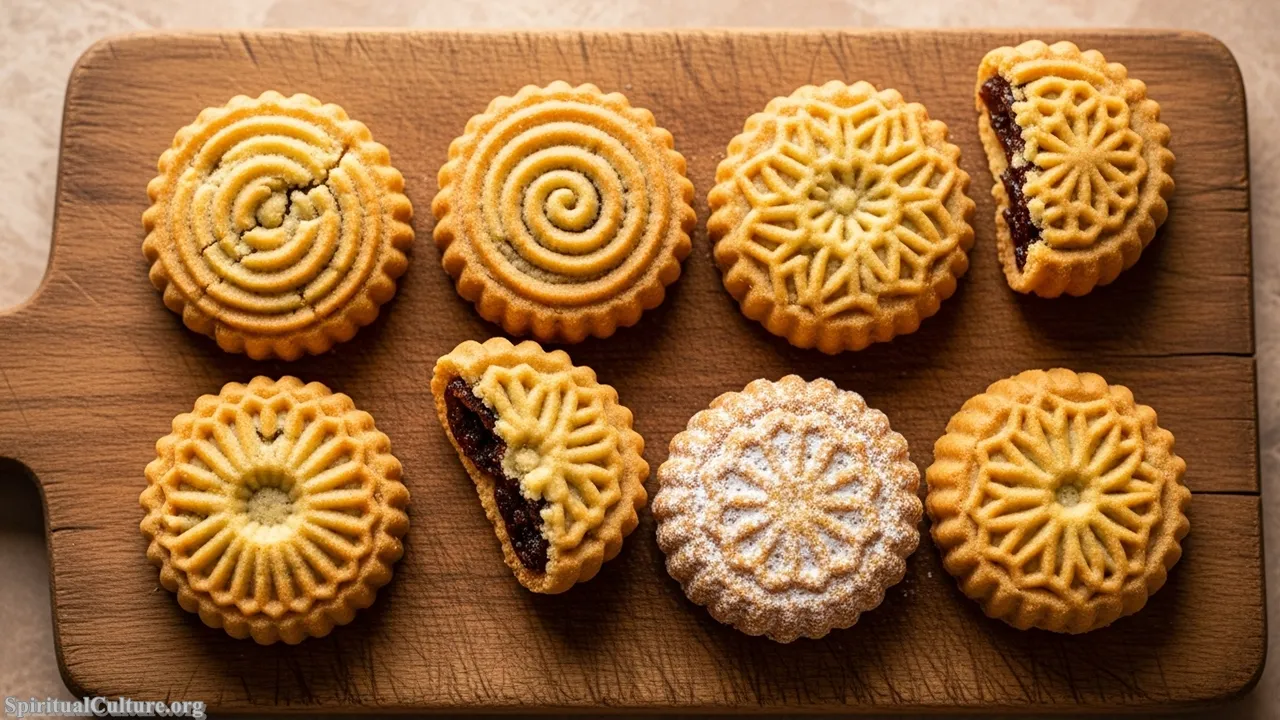
The ranking is secured by its undeniable spiritual symbolism. As the designated treat for Eid al-Fitr, it marks the successful completion of the holy month of Ramadan and a return to regular eating. The date filling links it directly to the most sacred fruit of the region, symbolizing blessing and prosperity. Moreover, the detailed work of molding the cookies represents the artistry and dedication inherent in preparing for a holy observance.
The preservation value of Ma’amoul lies in its ancient recipe, often touted as one of the oldest in the world, linking contemporary Saudis to centuries of tradition. Every bite is a taste of heritage and continuity. Spiritual Culture recognizes Ma’amoul as a beautiful emblem of transition and celebration, where a simple dessert becomes a complex work of art affirming the communal joy of a spiritual milestone.
Cultural/Spiritual Highlights
- The essential and most symbolic sweet served for Eid al-Fitr.
- Intricate designs from wooden molds (taba’) symbolize the artistry of heritage.
- Date-filled variations link the cookie to the sacred and staple fruit of the region.
Top 5. Dates & Qahwa (Arabic Coffee)
The pairing of Dates and Qahwa (Arabic Coffee) stands as a foundational pillar of Saudi Arabian social and spiritual culture, transcending all regional divides. The light-roasted Qahwa, often subtly flavored with cardamom and sometimes saffron, is served in small cups (finjal) alongside dates. This combination is the universal, non-negotiable act of welcome and hospitality extended to any guest in any Saudi home or majlis.

Its spiritual significance is deeply rooted in Islamic tradition. The Prophet Muhammad (PBUH) is recorded to have broken his fast with dates and water, making the date the definitive food for Iftar during Ramadan. This practice elevates the date from a simple fruit to a sanctified food of immense spiritual importance. The ritual of serving Qahwa, always poured sparingly to ensure constant attention to the guest, symbolizes the host’s generosity and respect (karam).
The act of sharing this combination is a non-verbal contract of peace and friendship, a pure expression of the host’s selfless devotion to the guest. It carries a profound moral lesson in honoring the visitor and practicing generosity in its simplest form. For Spiritual Culture, Dates and Qahwa are the very essence of Saudi hospitality, the fundamental ritual that underpins all cultural and spiritual interactions in the Kingdom.
Cultural/Spiritual Highlights
- The universal symbolic act of Saudi hospitality and welcome.
- Dates are the Sunnah food for breaking the fast (Iftar) in Ramadan.
- Qahwa is served with cardamom, symbolizing purity and honor for the guest.
Top 4. Saleeg
Originating from the Hejaz region, encompassing the holy cities of Makkah and Taif, Saleeg is a creamy, comforting rice dish affectionately dubbed the “Saudi Risotto.” It is traditionally prepared by cooking white rice in a mixture of chicken or meat broth and milk, often with a hint of cardamom, until it achieves a soft, porridge-like consistency. It is almost always served with a large portion of perfectly roasted meat (chicken or lamb) placed elegantly on top.

Saleeg’s cultural importance is tied to its deep roots in the most sacred heartland of the Kingdom. Often consumed during holidays, religious festivals, and as a main dish during family gatherings in the Western region, it represents purity, warmth, and the nurturing aspect of food. The inclusion of milk and the creamy texture sets it apart from other rice dishes, offering a uniquely comforting experience often associated with celebration and communal festivity.
This dish reflects a quiet dignity and the cultural value placed on soothing, nourishing food during significant events. The simplicity of its presentation, despite the richness of its flavor, speaks to the elegance of tradition. Spiritual Culture places Saleeg highly because it represents the specific, time-honored culinary heritage of the Hejaz, a cuisine refined by centuries of hosting pilgrims and rooted in the region’s unique climate.
Cultural/Spiritual Highlights
- A traditional, iconic dish of the Hejaz region, home to Makkah and Madinah.
- Its creamy, white color is associated with purity and comfort.
- Frequently prepared for Eid and other large celebratory feasts.
Top 3. Jareesh
Jareesh, a time-honored specialty of the central Najd region, is a humble yet powerfully significant dish made from crushed or cracked wheat, slow-cooked with laban (sour yogurt) or broth, and often topped with sautéed onions and spices. Its preparation is arduous, requiring hours of slow simmering, a process that reflects the patience and reverence for basic grains inherent in ancient agrarian and Bedouin societies.
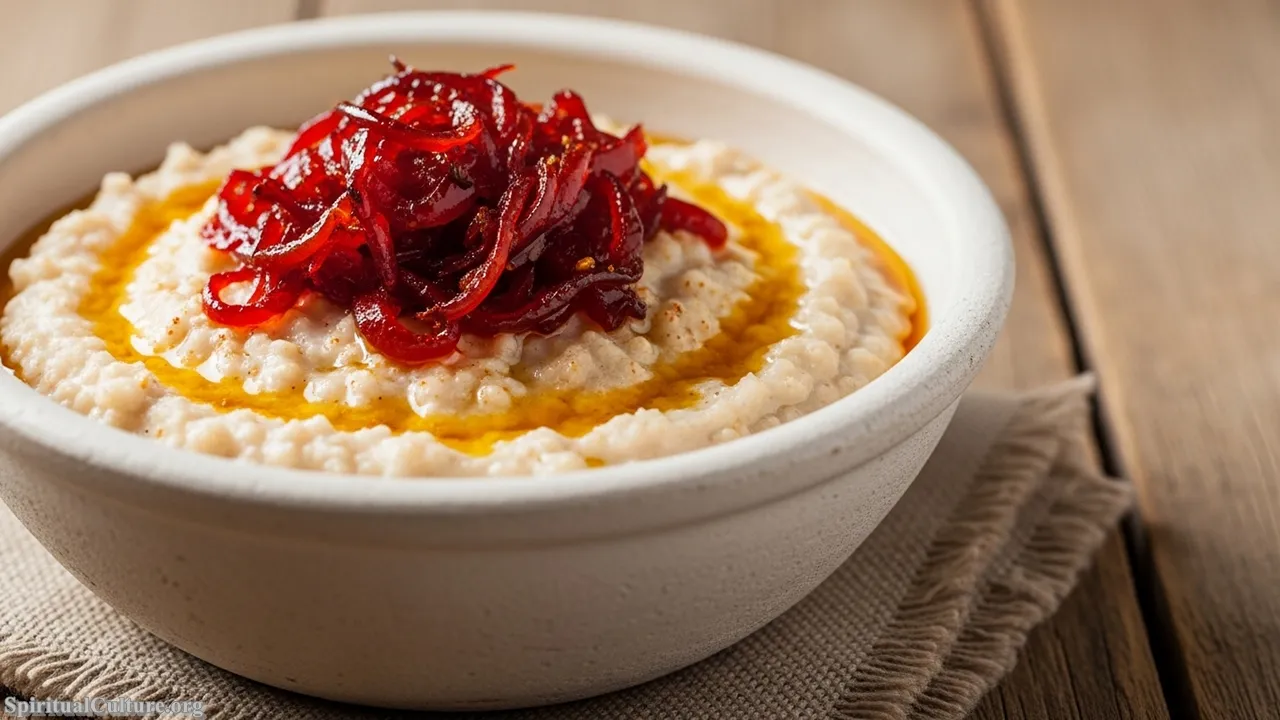
The deep spiritual significance of Jareesh lies in its historical role as a survival food and a symbol of sustainable sustenance. It was a primary staple for the resourceful Bedouins and farmers, providing a complete, high-energy meal from readily available ingredients. By utilizing simple cracked wheat, it teaches a spiritual lesson in gratitude for essential blessings and the ability to create richness from simplicity. The dish was so fundamental that it was officially recognized as one of Saudi Arabia’s national dishes in 2023, affirming its status.
Its place in Saudi heritage is secured by its continuity. It is a flavor profile passed down through centuries, binding the Najdi people to their ancestral lands and culinary wisdom. Spiritual Culture honors Jareesh as the “Pearl of Najdi Cuisine,” a living artifact that celebrates the dignity of hard work and the cultural ingenuity born of the desert environment.
Cultural/Spiritual Highlights
- Officially recognized as a National Dish (alongside Kabsa) in 2023.
- Made from Jareesh (cracked wheat), a historic staple of the desert tribes.
- Symbolizes resourcefulness, patience, and nourishment derived from the land.
Top 2. Mandi
While Mandi originates from Yemen, its widespread and fervent adoption across Saudi Arabia, and particularly its association with grand feasts, has made it an unshakeable cornerstone of the Saudi culinary tradition. Mandi is distinguished by its unique preparation: meat (lamb or chicken) is marinated with a special blend of spices and traditionally slow-cooked in a deep pit or earth oven (Tabun or Tannour). This method imparts a distinctive smoky flavor and ensures the meat is incredibly tender, which is then served over rice cooked in the meat’s drippings.
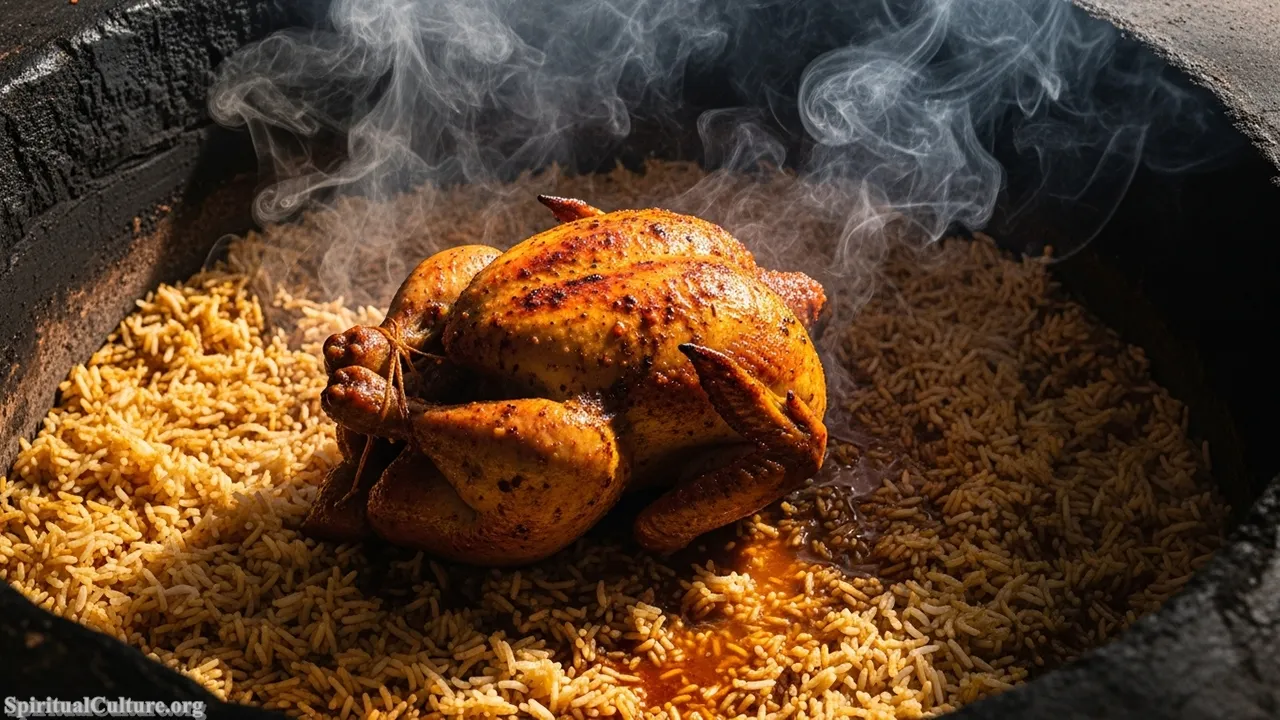
Mandi’s high ranking is due to its potent symbolism of generosity and celebration. It is an essential item for massive gatherings—weddings, major Eid celebrations, and welcoming the most honored guests. The tradition of cooking in a pit oven links it to ancient Bedouin hospitality practices, showcasing the host’s willingness to dedicate time and resources for the guest’s honor. It is a spiritual statement of abundance and profound respect.
The dish is almost universally served on a large communal platter, encouraging guests to eat from the same shared vessel—the ultimate expression of unity and equality. This communal aspect is deeply humanistic and reinforces the social bonds essential to the culture. Spiritual Culture views Mandi as the ultimate feast icon, a magnificent blend of flavor and tradition that embodies the grandeur and depth of Arabian hospitality.
Cultural/Spiritual Highlights
- The essential dish for Weddings and Grand Celebrations, symbolizing abundance.
- Characterized by the Bedouin cooking method of slow-roasting in an earth oven (Tannour).
- Universally served on a massive communal platter, emphasizing unity and sharing.
Top 1. Kabsa (Kabsah)
Kabsa is undeniably the reigning monarch of Saudi cuisine. Revered as the National Dish of Saudi Arabia, it is a hearty and complex mixed rice dish featuring tender meat (most commonly lamb, chicken, or goat) slow-cooked with long-grain Basmati rice, and a fragrant blend of spices like cardamom, saffron, cinnamon, and dried black lime (loomi). Its pervasive popularity across all regions and social classes is unmatched, making it the definitive taste of the Kingdom as of the Current Time of Writing.

Its cultural and spiritual significance is monumental. Kabsa is the embodiment of Saudi Karam (generosity/hospitality). It is the first dish offered to a guest and the primary dish for major family and community meals. The one-pot cooking method, combined with its presentation on a single, oversized platter from which all diners eat, makes it a potent symbol of communal sharing, familial unity, and respect. It is the culinary cornerstone of every celebration and a source of profound national identity.
The preservation value of Kabsa lies in its fundamental place in the Saudi home kitchen—it is a recipe every mother and chef perfects. It is a living tradition that evolves with local spices yet remains fundamentally the same in its core mission: to honor the guest with a magnificent, shared meal. Spiritual Culture celebrates Kabsa as the highest expression of Saudi culinary identity, a rich, aromatic synthesis of heritage, flavor, and the spiritual virtue of unwavering hospitality.
Cultural/Spiritual Highlights
- Universally recognized as the National Dish and the ultimate symbol of Karam (Hospitality).
- The inclusion of Loomi (dried black lime) provides a signature Saudi spice profile.
- Eating from a large, single communal platter reinforces family and community unity.
Conclusion
The cuisine of Saudi Arabia is a vibrant, profound expression of a culture built on generosity, reverence for the land’s blessings, and the deep sanctity of communal gathering. From the unifying platter of Kabsa, which binds friends and family, to the spiritual sustenance of Dates and Qahwa, these dishes are more than ingredients—they are edible monuments to the Kingdom’s heritage. The diversity from the comforting Saleeg of the Hejaz to the ancient Jareesh of Najd tells a story of a nation unified in faith but rich in regional flavor. By understanding the spiritual meaning woven into every recipe, we truly appreciate the humanistic depth of Saudi culture. This rich culinary heritage must be honored and preserved for future generations, ensuring that every feast continues to be a sacred act of sharing and love.

